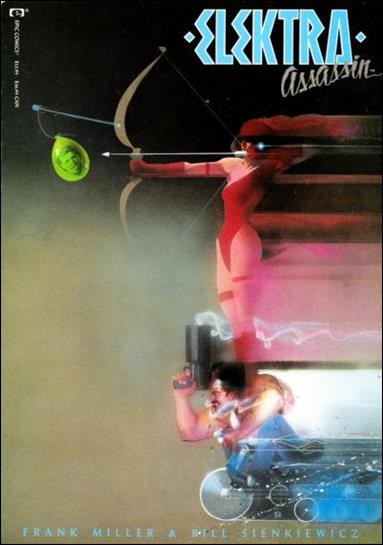 By FRANK MILLER, BILL SIENKIEWICZ (Epic Comics; 1986/87)
By FRANK MILLER, BILL SIENKIEWICZ (Epic Comics; 1986/87)
The Frank Miller scripted, Bill Sienkiewicz illustrated ELEKTRA ASSASSIN, from Marvel’s adult-oriented offshoot Epic Comics, was a vital yet largely unheralded entry in the comics renaissance of the 1980s. Initially published as an eight issue miniseries and then as a graphic novel, its hallucinatory narrative, expressionistic visuals and satiric thrust marked out ELEKTRA ASSASSIN as one of the most innovative comics of its time. Furthermore, in light of the formulaic Jennifer Garner movie about the Elektra character and Miller’s own subsequent work, which tends to be heavy-handed and fascistic in tone, ELEKTRA ASSASSIN retains much of its subversive edge.
Miller and Sienkiewicz were evidently fully aware of the ridiculousness of their material, whose plot is adequately summed up by this incredulous dialogue snippet: “I’m under psychic domination by a ninja assassin with magic powers with a body almost as good as yours who needs to kill Ken Wind because he’s possessed by a demon.” The speaker is a cyber-enhanced S.H.I.E.L.D. agent named Garrett (S.H.I.E.L.D., the Marvel law enforcement agency, is portrayed here as lumbering and ineffectual), Ken Wind is a corrupt democratic presidential candidate and the demon is “The Beast,” an entity determined to bring about a nuclear Armageddon, while the assassin in question is Elektra, who debuted—and got killed off—in the Frank Miller scripted run of DAREDEVIL. ELEKTRA ASSASSIN was conceived as a standalone prequel to the latter.
There’s no sense going too deeply into the narrative, which is only semi-coherent. Related in the type of stream-of-consciousness manner that would come to typify later Miller works (like THE DARK KNIGHT STRIKES AGAIN), it’s often impossible to follow, with the textual news briefs that begin each chapter being the only way to discern what precisely is going on.
What really gives ELEKTRA ASSASSIN its spark is the artwork of Bill Sienkiewicz. Rendered in watercolor imagery that runs the gamut from exaggeratedly cartoony to overtly hallucinatory, the illustrations here are among Sienkiewicz’s most striking work in the comic book field, and certainly his most daring. His portrayal of Ken Wind, as a grainy photographic face (patterned, reportedly, on Sienkiewicz’s own features) that perpetually wears a vapid smile, is especially notable, as are his renderings of action sequences in the form of oft-indistinct splashes of color.
Sienkiewicz’s take on Miller’s script is equally striking. The artwork doesn’t always follow Miller’s descriptions, and indeed often clashes with them. A large part of ELEKTRA ASSASSIN’S charm is in the interplay of art and text, a collaboration that’s quite dynamic, if not always complimentary. According to the introductory comments by editor Jo Duffy, Miller often rewrote his scripts after seeing the finished artwork, and there’s no question that Sienkiewicz’s art drives this project, and remains its standout element.
